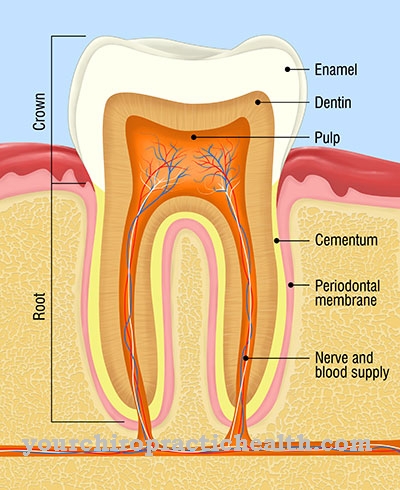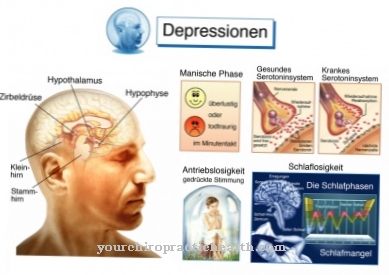With the present Nephrosclerosis a person's kidney is affected. Early treatment steps usually increase the success of the treatment.
What is nephrosclerosis?

© Crystal light - stock.adobe.com
The Nephrosclerosis is a kidney disease also known as vascular or hypertensive nephropathy. Nephrosclerosis is very often associated with increased blood pressure in those affected.
A distinction can be made between so-called benign (benign) and malignant (malignant) nephrosclerosis. The benign form of nephrosclerosis is characterized, among other things, by the formation of hardening on the arterioles (the smallest arteries of the kidney). The benign form of nephrosclerosis often does not initially cause any symptoms in those affected; if symptoms occur, these can be seen, for example, in headache, restlessness and / or loss of appetite.
While benign nephrosclerosis usually does not affect kidney function, affected patients are often more prone to kidney inflammation.
As part of malignant nephrosclerosis, changes in kidney tissue and vascular walls occur in most cases. Symptoms of the advanced disease include blurred vision or confusion.
causes
A benign one Nephrosclerosis often follows from an atherosclerosis (hardening of the arteries) in the person affected, which is associated with increased blood pressure.
The malignant form of nephrosclerosis can be caused, for example, by very high blood pressure. Various kidney diseases and the use of contraceptive medication can also promote malignant nephrosclerosis. The role of various viral diseases in triggering malignant nephrosclerosis has not yet been conclusively clarified.
The occurrence of nephrosclerosis can also be favored by various risk factors. These risk factors include, for example, a high level of nicotine consumption, cases of nephrosclerosis that occur more often in the family, existing disorders of lipid metabolism and / or impaired kidney functions.
Nephrosclerosis occurs comparatively often in people of older age, male sex or black skin color.
Symptoms, ailments & signs
Nephrosclerosis always occurs together with increased blood pressure, since high blood pressure is the only cause of the sclerotic changes in kidney tissue. In most cases, there are no symptoms at the beginning of the disease, as both high blood pressure and nephrosclerosis can initially be asymptomatic. Often, however, unspecific symptoms of hypertension such as visual disturbances, dizziness or even tightness in the chest are perceived.
Depending on the high blood pressure, the development of two different forms of nephrosclerosis is possible. There is a benign (benign) and a malignant (malignant) form of this disease. In the case of benign nephrosclerosis, no symptoms are usually observed. An increased excretion of proteins can only be determined in blood tests.
If left untreated, however, kidney failure can develop after a very long time, which is noticeable in the form of decreased urine production, the formation of pulmonary edema, cardiac arrhythmias and muscle weakness. Before this condition occurs, however, the disease processes in benign nephrosclerosis can be stopped and even reversed. The symptoms of malignant nephrosclerosis are similar, but this is a sudden onset and rapidly progressing disease process.
In the case of acute kidney failure, this can be fatal. In addition, there is also nausea, vomiting, severe headaches, states of confusion, indifference, coma and cramps, which can often lead to heart failure. The blood pressure rises sharply. A cure for renal insufficiency is often no longer possible at this stage of the disease.
Diagnosis & course
The diagnosis of a present Nephrosclerosis usually begins with a detailed consultation with the patient. As part of this conversation, a treating doctor asks, for example, the duration and severity of the symptoms.
Information on a patient's medical history is also usually asked for. Information gained from the conversation can then be supplemented, for example, by examinations of the blood and urine of an affected person; for example, the suspicion of nephrosclerosis can be corroborated by an increased protein concentration in the urine. Malignant nephrosclerosis can usually only be confirmed with a biopsy (a removal of kidney tissue).
Benign nephrosclerosis usually progresses slowly. Occasionally, kidney failure can occur in the advanced stages. Malignant nephrosclerosis can damage the heart and brain due to high blood pressure. Severe disease can result in comas and / or heart failure.
Complications
As a result of nephrosclerosis, those affected mostly suffer from kidney problems. However, these have a very negative effect on the overall health of the patient, so that there is an inner restlessness and furthermore high blood pressure. Those affected are often confused and suffer from headaches and bleeding. Nephrosclerosis can also cause visual disturbances so that patients have blurred vision.
Coordination disorders and concentration disorders also occur, which have a very negative effect on the patient's quality of life. Those affected are equally listless and exhausted and no longer actively participate in life. Furthermore, the nephrosclerosis also leads to vomiting and permanent nausea in the patient. Nephrosclerosis is treated with a kidney transplant or dialysis.
In most cases, however, it is necessary to remove the damaged kidney before the kidney becomes completely insufficient. However, if treatment is successful, the patient's life expectancy is not affected. A healthy diet and lifestyle can have a positive effect on nephrosclerosis and reduce symptoms and symptoms.
When should you go to the doctor?
Symptoms such as loss of appetite, restlessness, stomach pain or headache point to nephrosclerosis or at least to a serious condition, which must always be clarified by a doctor. Anyone who notices these or other symptoms that cannot be traced back to a specific cause should consult their family doctor. A medical examination is necessary in any case, as otherwise serious complications such as chronic gastrointestinal complaints, visual disturbances or internal bleeding can occur.
People who consume nicotine regularly or have a fat disorder are particularly at risk. The same applies to patients who have overcome a viral disease or who have atherosclerosis. Anyone who belongs to these risk groups must have the complaints clarified immediately. In addition to the general practitioner, an internist or a specialist in arterial diseases can be consulted. In the case of serious illnesses, a visit to a specialist center is necessary. The actual treatment is usually carried out in a special clinic, whereby, depending on the type and severity of the nephrosclerosis, other specialists can be included in the treatment.
Treatment & Therapy
Medical treatment of the Nephrosclerosis usually focuses primarily on lowering blood pressure. Various medicinal products are available for this purpose.
The attending physician assesses which antihypertensive agents are suitable in each individual case, taking various factors into account; For example, for those affected by nephrosclerosis with increased protein concentration in the urine, different preparations may be useful than for patients whose urine has a normal protein concentration.
The medical recommendations regarding blood pressure values to be achieved in the treatment of nephrosclerosis also vary depending on various factors; For example, the recommended blood pressure values for patients with impaired kidney function are below the recommended values for those with intact kidney function.
Early and professional therapy can often save lives, especially in patients with malignant nephrosclerosis. The background to this is that if untreated, malignant nephrosclerosis leads to kidney failure in most cases. If such kidney failure has occurred, treatment steps such as regular hemodialysis (blood washing) or surgical removal of the diseased kidney may be necessary.
Outlook & forecast
Nephrosclerosis is a consequence of chronic high blood pressure. The prognosis can vary greatly depending on whether the disease is benign or malignant. Benign nephrosclerosis can persist for many years. During this period, the kidney tissue is constantly damaged and new connective tissue is produced, which causes tissue hardening in the kidney. The consequences of this development are kidney pain, hormonal changes and a decrease in general well-being.
The malignant form of nephrosclerosis is accompanied by a sudden deterioration in kidney function. The blood pressure rises sharply and a hypertensive crisis occurs, which is potentially life-threatening. First of all, with both forms, the aim is to lower blood pressure, for which different drugs are used. The prescribed antihypertensive drugs can cause side effects and make the patient feel unwell.
The malignant form leads to the death of the patient in many cases. In the benign form, a long, relatively symptom-free life is possible. However, the quality of life is limited solely by possible side effects and interactions of the drug administration as well as by the progressive increase in symptoms.
prevention
That is to be prevented Nephrosclerosis especially by avoiding or combating high blood pressure. For this it can be useful to have your blood pressure checked regularly. Avoiding risk factors such as heavy smoking can also help prevent nephrosclerosis. If nephrosclerosis has already set in, regular visits to the doctor enable early therapy.
Aftercare
In most cases, the direct follow-up measures for nephrosclerosis are significantly limited and in some cases are not even available to the person concerned. They should therefore consult a doctor early on so that there are no further complications or complaints. Self-healing cannot occur, so that a doctor should be consulted at the first signs and symptoms.
During the treatment of nephrosclerosis, regular check-ups and examinations by a doctor are necessary in order to identify and prevent further symptoms at an early stage. Many of those affected are dependent on taking medication, whereby it is important to ensure the correct dosage. In the event of uncertainties, side effects or other questions, a doctor should always be consulted first.
As a rule, the help of relatives and one's own family is just as important in preventing depression and other mental disorders. The further course of the disease is very much dependent on the time of diagnosis of the nephrosclerosis, so that no general course can be predicted. However, in many cases the disease can reduce the life expectancy of those affected.
You can do that yourself
Nephrosclerosis patients can assist treatment by avoiding activities that increase blood pressure. The diet should be changed accordingly. It is important to avoid spicy foods. Coffee should also only be drunk in limited quantities.
The symptoms of nephrosclerosis can also be alleviated by doing moderate exercise. In order to avoid complications, physical activities should first be discussed with a doctor. If available, a blood pressure monitor can be used to measure blood pressure yourself at home. If particularly high blood pressure is found, the doctor should be informed. Elderly people and people with other kidney diseases have particularly poor prospects of recovery. You should make the necessary lifestyle changes to optimally support therapy. These include exercise and a balanced diet, avoiding alcohol and nicotine and avoiding stress.
Nephrosclerosis patients should speak to the responsible nephrologist in order to coordinate their lives optimally with the disease, which is usually associated with numerous restrictions. If kidney failure occurs as a result of the disease, the emergency services must be called. The patient should lie down quietly and take emergency medication if available.


.jpg)
.jpg)





















.jpg)

.jpg)
